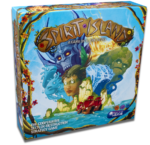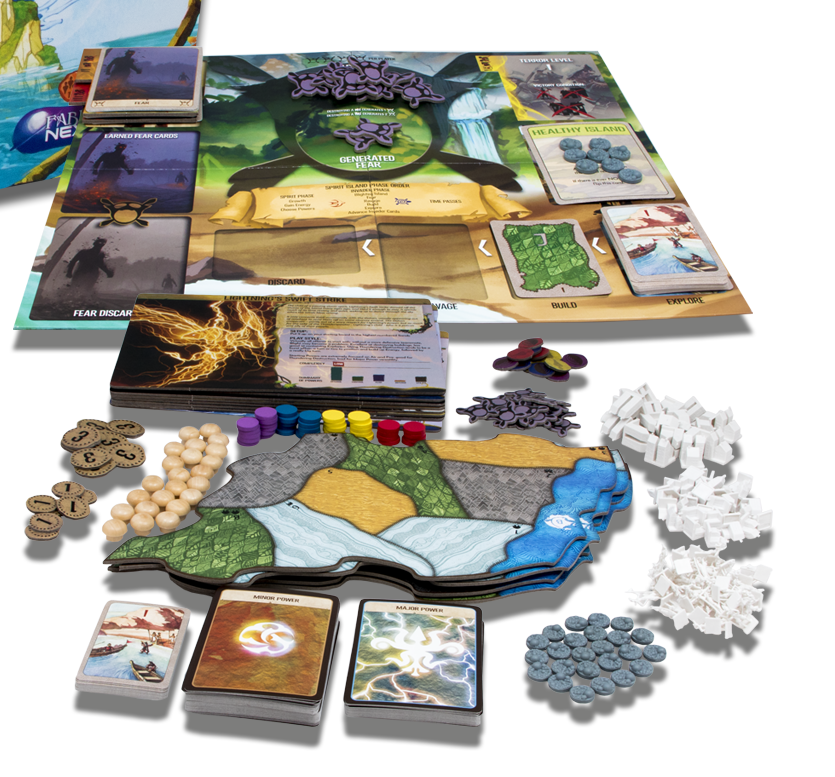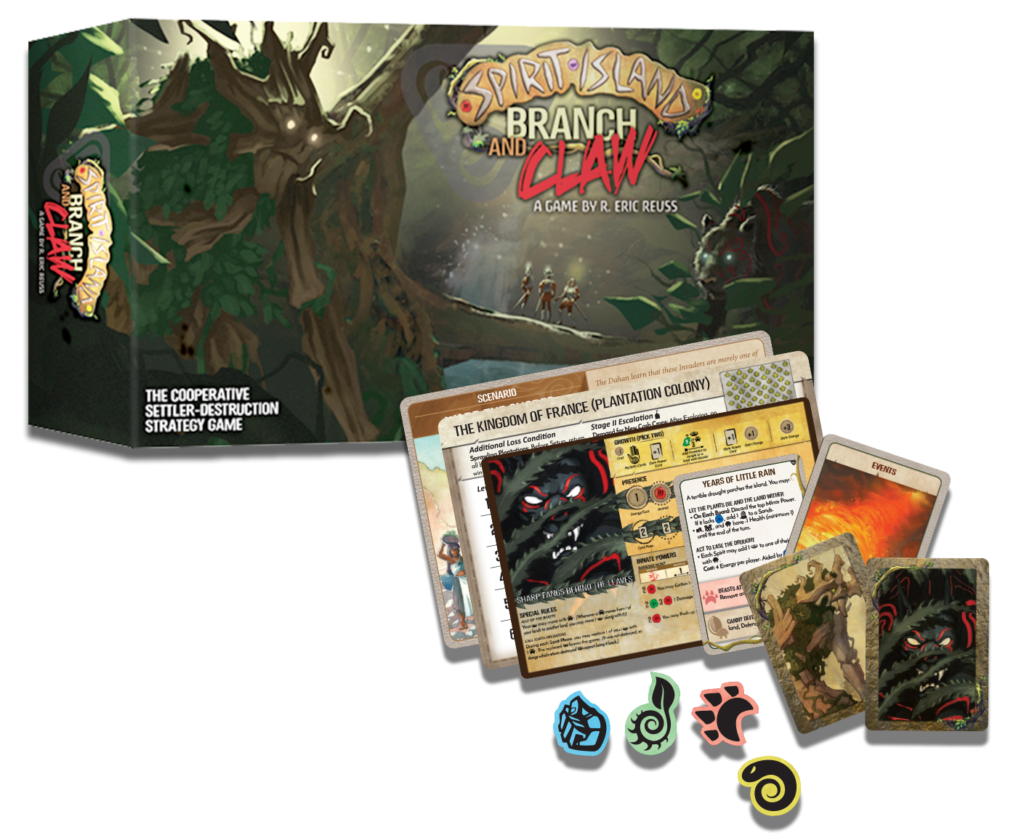Spirit Island (Boardgame)
 Sometimes the whole metaphorical peanut butter and chocolate combination sneaks up on you and surprises you with you didn’t even know you were missing. Spirit Island, the cooperative settler-destruction strategy game is not for the faint of heart, but it distills nearly all my favorite boardgame elements into a single game. Cooperative game? Check. Asymmetric (each player has different powers) Gameplay ? Check. Deckbuilding? Check. Player Development (increase in power during the game?) Check. Simultaneous player decisions? Check. Multiple scenarios or options for play? Double, Triple, & Quadruple Check. Quick to play, easy to learn, a great fit for any crowd?….. well, you can’t have everything. For gamers willing to put up with a bit of a learning curve (really only a game or two), Spirit Island offers a deeply strategic, cooperative game with plenty of variations to explore.
Sometimes the whole metaphorical peanut butter and chocolate combination sneaks up on you and surprises you with you didn’t even know you were missing. Spirit Island, the cooperative settler-destruction strategy game is not for the faint of heart, but it distills nearly all my favorite boardgame elements into a single game. Cooperative game? Check. Asymmetric (each player has different powers) Gameplay ? Check. Deckbuilding? Check. Player Development (increase in power during the game?) Check. Simultaneous player decisions? Check. Multiple scenarios or options for play? Double, Triple, & Quadruple Check. Quick to play, easy to learn, a great fit for any crowd?….. well, you can’t have everything. For gamers willing to put up with a bit of a learning curve (really only a game or two), Spirit Island offers a deeply strategic, cooperative game with plenty of variations to explore.
Spirit Island
Designer: R. Eric Reuss
Publisher: Greater Than Games
Players: 1-4
Ages: 13+
Time: 90-120 minutes (depending on player count)
(review copy provided by publisher)
Spirit Island is a difficult game to explain as it has so many interrelated parts. It is difficult to decide where to start. Thematically, the players are Spirits on the island who have learned to live peacefully (more or less) with the island’s inhabitants, the Dahan. All is well until colonists from far off lands appear and begin their slash and burn the land into submission. As protectors of the island, the spirits wish to chase them off but as forces of nature they can’t directly challenge the colonists. Instead, the spirits use indirect means, the Dahan, and the forces of nature in order to wipe out the colonists or at least scare them enough so they leave. The game has players taking on a role of a particular spirit, with different strengths and weaknesses, in a combined effort to destroy and/or chase off the colonists before the island is permanently damaged beyond repair.

A standard round in Spirit Island consists of three main parts, with players all making their decisions at the same time. First the Spirits (players) grow in power (“Growth”) and are able to use some of their abilities (the Fast ones) to affect the game board. Next, as in most cooperative games, “Bad Things Happen.” In this case, colonists on the board attack the land (and any Dahan inhabitants), build new colonization structures, and send out more explorers (entering new territories.) Finally, the round ends with Spirits using their Slow abilities (often more powerful than Fast ones) to try to clean up the mess created during the round.
Standard for any cooperative game, there are several ways for the players to lose. Letting the colonists damage the land (called Blight) in too many areas, letting a Spirit (player) completely knocked off the island, or simply taking too long to satisfy the victory conditions. There are optional Scenario setups that provide additional ways to lose. In the meantime, players are attempting to win the game either by physically eliminating the colonists, or scaring them away (by generating “Fear”, a resource within the game.) The two are synergistic. As more fear is produced, the elimination requirements become more lax. For example, players can reach a point where they only need to destroy all the colonists’ structures but don’t need to destroy the individual colonist explorers for a win.
Players affect the island through the use of their spirit’s cards and special powers. Each spirit begins with a small hand of cards that they can play to affect the board. Cards cost energy to play (0 to 5 or so) and once spent, cannot be used again until they are retrieved from the discard pile. Every card displays one or more colored “elements” on the left hand side. Spirits have innate powers that can be used “for free” if specific color combinations are satisfied. More powerful abilities are triggered when larger combinations are achieved. Abilities are often limited to specific areas of the board, either at or near locations where a Spirit has “Presence” on the board. This is represented by round tokens of that spirit’s color. Placing Presence on the board is one of the main Growth options that can be chosen at the start of a round. Adding new tokens to the board is useful to be able to affect a wider area, but when tokens are placed on the board they are first removed from a player’s play area, exposing newly upgraded abilities for that Spirit. Typically, placing a Growth token (by removing it from a player’s area) will grant a player the ability to play more cards in a turn (most Spirits start at only 1 card per turn) or gather additional Power per turn (so that more expensive card can be played.) Three other Growth options exist. One is to choose to take back all of one’s discarded cards so they become available for play again. Another is simply to gain extra power to spend on playing more cards, The final option is to choose a new power from a common deck of power cards. Usually, a Growth option for a Spirit includes a combination of several of the above. In this way, Spirits will become more and more powerful as the game progresses, able to play more cards and more powerful ones.
Meanwhile, the colonists continue to take names and kick backsides. The island board is set up so that each player starts in a section (so the board is larger for games with more players.) The game starts with a few colonists present, a few explorers, a town or two, and a city. Each board has two spaces of each of the four types of terrain: desert, wetlands, jungle, and mountains. In one round one terrain type will be ravaged (attacked), one terrain type will have colonists build new structure, and terrain (always a unknown until it is flipped over) has new colonists appear on the board. The cards progress so that the explored terrain this time will be building the next round and ravaging the round after that. This provides the players with a preview of what will happen in the coming turns but leaves the near future (where the new explorers will land) unknown. Ravaging has colonists in that terrain type attacking the land and any Dahan present. Explorers, Towns, and Cities all attack and have a hit point value of 1, 2, and 3 respectively. First colonists attack the land, adding a Blight token if they do at least 2 damage (some cards and powers can reduce damage so it isn’t a given that an area will Blight.) Of course, if there’s already Blight there a chain reaction happens and additional Blight will appear in an adjacent land. Colonists also attack the local Dahan (if any are present) doing the same amount of damage. Dahan have two hit points each and if any survive they do two damage back to the colonists (this can be useful, particularly if you have ways to help defend the Dahan so they don’t die first.) After the Ravage phase, the colonists Build. If there are more towns than cities in a territory, a city is built. Otherwise, the colonists build a town. This is bad news, of course, since these same territories are the ones who will be Ravaging in the next round. Finally, the top card of the Colonist deck is flipped over to reveal what territory is explored this turn. Any territories of that type that are adjacent to a town, city, or the coast will gain an explorer. On a side note, this means that if a Spirit can cleanse buildings from the inland portion of their area, it will limit the number of explorers that appear. If the Spirits are slow to win (or lose) the game, the last few cards of the Colonist deck contain TWO different territory types, creating a wave of exploration and building. Survive until the last card of the Colonist deck is revealed, and you’ll lose anyway from taking too long.

As I’ve mentioned, there are a huge number of ways to change up the game from play to play. The game comes with eight different spirits with a wide range of abilities. To help new players each Spirit is ranked for complexity as well as its style of play: is it defensive, offensive, does it generate a lot of fear, is it perhaps particularly good against Blight? The four least complex Spirits also come with a list of recommended upgrade cards from the bonus power deck. This helps new players by picking out cards that are particularly synergistic with that Spirit. Beginner games start with a simple set of Blight tokens, when they run out the Spirits lose. However, later games recommend going with a Blight card which starts off normal, but after a small number of Blight tokens are removed the card flips over and now causes an ongoing disadvantage to the Spirit players. For a more thematic game, there are specific invader types that change up how the game works (you can go up against colonists from England, Brandenburg-Prussia, or Sweden.) On top of all this, four optional Scenarios can be used with or without any of the above to give yet another style of play. For example, I’m partial to the Blitz Scenario. This makes all Spirit powers occur before the colonist phase, but it compensates by giving the colonists a bigger head start.

If your eyes haven’t glazed over yet, there is a complete expansion available for the game. It provides more power cards, more blight options, new scenarios, and two entirely new Spirits with which to play. The new mechanisms in the expansion are a set of four different types of tokens and an Event deck. The four types of tokens work in favor of the Spirits. They can sometimes prevent ravaging, building, or exploration. The fourth type of token adds in Wild Beasts which can outright eliminate some colonists. As for the event deck, each round a card is flipped over to add a new twist to the round. Every event card has three effects. One main event has large effects and may even offer a strategic choice to the players. The next effect manipulates the expansion tokens in some way. The last effect has the Dahans acting in some way (moving, attacking, aiding the spirits, etc…). Of course, the new Spirits, Power Cards, and Events make good use of the tokens to give a new flavor to the game.
Verdict
There are many more complicated boardgames around, but this isn’t a game for casual gamers. Gamers familiar with a wide range of boardgames will find it approachable. Their first game may take awhile, but the game speeds up in subsequent games as everyone takes their turns simultaneously. The one danger is for players who over analyze situations. There are a lot of moving parts and trying to completely optimize every single maneuver can slow the game to crawl. Complexity aside, the huge variety gives gamers plenty to explore. Each Spirit has their own play style and using the optional scenarios or Invader types (or both) keeps the game fresh. The artwork and backstory should be noted. They combine to capture a sense of the otherworldly when reading the flavor text, conjuring up visions of ethereal spirits attempting to protect the land despite their limitations.
Spirit Island takes some of my favorite boardgame ideas (cooperative, deckbuilding, building up power throughout the game, and the huge variety of game options) and squishes them into a single, unified whole. The multitude of customization options should keep it fresh for some time to come.
Kid Factor
The recommended age limitation of 13+ is a great place to start, although my eldest (a preteen and a gamer) was able to play competently. My mid-elementary was able to stumble through it but lost focus halfway in. There is a strong spiritualism theme, but it is story-based and not sold in any religious sort of overtones. The art is very evocative, colorful with a bit of eastern artistic flair, but it would be a stretch to find any of the images inappropriate. I always give cooperative games a bump up in ratings as they work so well in otherwise competitive family gaming. Since there is plenty going on, Spirit Island is less likely to suffer from the alpha-player syndrome where one person dominates all the decisions. The main stumbling block would be the complex interactions on the board. For kids (or gamers of any ages) who are willing to give it a try, it offers some great gaming experiences.





April 17th, 2018 at 2:53 pm
I love this game! And I am normally only so-so about co-ops. This one is special though!